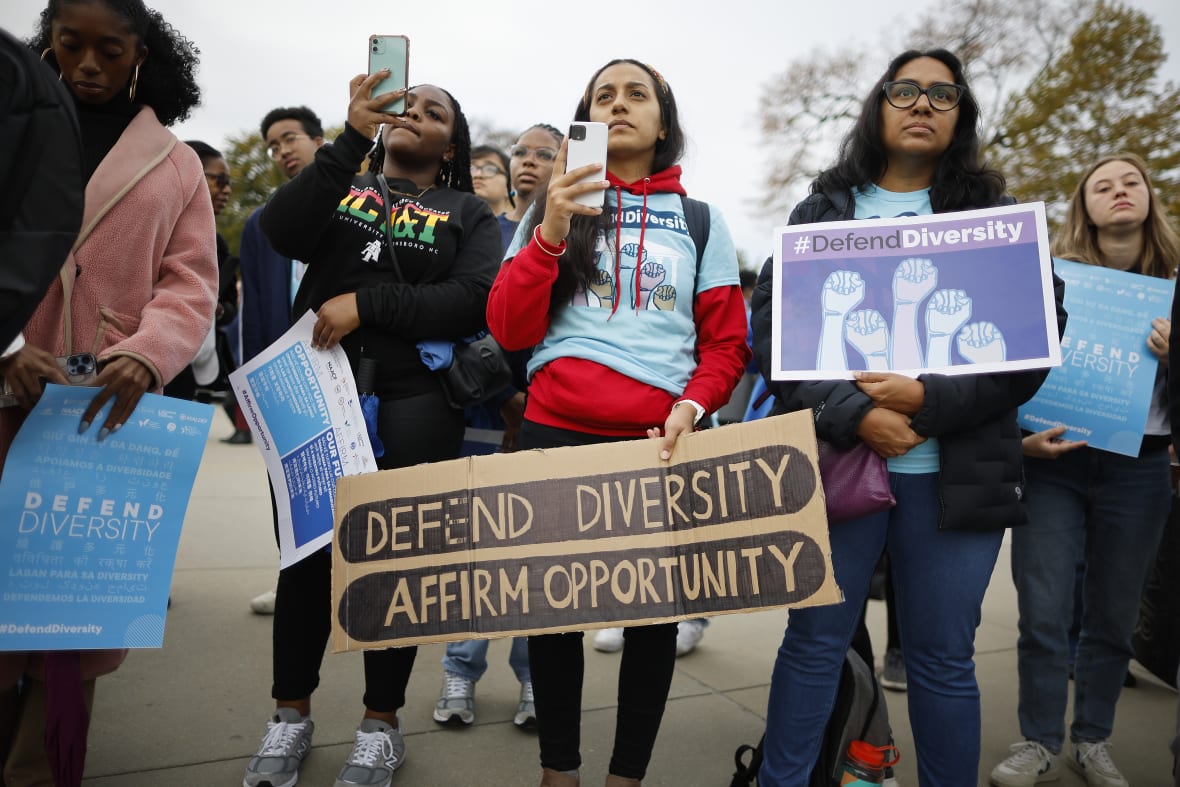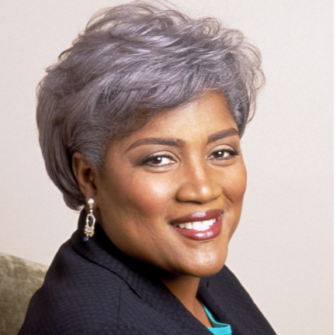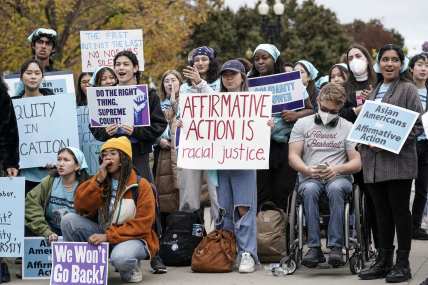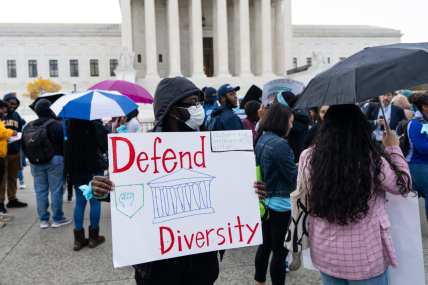Supreme Court affirmative action decision hurts Black students. Here’s how colleges should respond.
OPINION: Thursday’s ruling barring colleges from considering race in admissions is a blow to Black, Hispanic and Native American high school students with great potential. Colleges need to find alternate ways to attract those students and commit to maintaining a diverse student population.

Editor’s note: The following article is an op-ed, and the views expressed are the author’s own. Read more opinions on theGrio.
The Supreme Court ruling Thursday barring public and private colleges and universities from considering race when deciding which students to admit strikes a terrible blow against striving Black students and poses a grave challenge to efforts to increase campus diversity.
The 6-3 ruling came in two cases challenging affirmative action admissions programs at Harvard University and the University of North Carolina that considered race as one of many factors in reaching admissions decisions. The high court said race-conscious admissions are unconstitutional.
The universities were sued by a group claiming affirmative action policies benefitting Black, Hispanic and Native American students discriminated against white and Asian American students. Harvard and UNC said quite correctly that such programs promote diversity that enhances the education of all students.
Affirmative action also benefits society by broadening the pool of college graduates, enabling employers to take advantage of their talents and experiences.
Black people make up about 14% of the U.S. population. However, the percentage of Black students in highly selective colleges and universities that can help graduates land high-paying jobs is only 7.1%. It could plummet to just 2.1% without race-conscious affirmative action, 33 selective schools said in a written argument to the Supreme Court supporting Harvard and UNC.
A drop in college enrollment would worsen the higher education gap already disadvantaging Black Americans. The Census Bureau reported in 2021 that while some 61% of Asian Americans and almost 42% of non-Hispanic whites 25 and older held bachelor’s degrees, the comparable figures fell to about 28% for Blacks, nearly 21% for Hispanics and about 15% for Native Americans.
The Supreme Court ruling could hurt many Black, Hispanic and Native American high school students with great potential for achievement — unless schools find alternate ways of maintaining and preferably increasing diversity.
Finding those alternate ways is vital. Affirmative action programs can benefit minority students even while ignoring race by giving favorable consideration to obstacles college applicants have had to overcome, such as poverty and being first-generation college students. Colleges should now intensify efforts to attract more such students and help them succeed once enrolled.
One effective action public colleges and universities should take would be to pledge to admit top students from all high schools in the states where they are located. Texas successfully launched such a policy in 1998, guaranteeing college admission to the top 10% of graduates of every high school in that state. Students at high schools with large Black and Hispanic enrollments benefitted.

Justice Clarence Thomas, one of two Black members of the Supreme Court, said in a 1983 speech that he benefitted from affirmative action. He received a scholarship set aside for racial minorities to attend Holy Cross College and was admitted to Yale Law School in 1971 and given generous financial aid under an affirmative action program.
Nevertheless, Thomas voted to strike down race-conscious affirmative action. Justice Ketanji Brown Jackson, the other Black member of the Supreme Court, voted to uphold race-conscious affirmative action at UNC but recused herself from the Harvard case because she served on a university board.
In her dissent to the majority decision, Jackson wrote that “deeming race irrelevant in law does not make it so in life.”
Opponents of race-conscious affirmative action programs fail to take into account the many historical and contemporary realities that justify such programs.
For example, before the Civil War, Southern states made it a crime to teach both enslaved and free Black people to read and write, although some Black people overcame these obstacles. When slavery ended in 1865, many newly freed Black Americans had no education, no money and no property.
Besides facing the hardships of poverty and the systemic racism that continue to plague America, many Black students attend schools in low-income neighborhoods. These schools are often poorly funded, have too few teachers, have substandard facilities and don’t offer many Advanced Placement and International Baccalaureate courses that impress college admissions officers.
In addition, many low-income high school students — who are disproportionately Black — must hold after-school and summer jobs to help support their families, rather than participating in extracurricular activities, unpaid summer internships, and expensive summer enrichment programs that stand out on college applications.
On top of this, few Black students have parents who graduated from selective colleges and universities and donate money to such schools. Students (most of them white) with such parents have long received preferential treatment in admissions to colleges their parents attended.
Higher education institutions launched affirmative action programs in the 1960s and 1970s to increase minority enrollment. Since then, affirmative action has become a key component of diversity, equity and inclusion (DEI) initiatives designed to open the doors to the American Dream to all Americans.
In earlier years, affirmative action (although it wasn’t called that) was in force for white students, barring most Black students from admissions to predominantly white colleges and universities. Some colleges in the South refused to admit any Black students as recently as the early 1960s.
Fortunately, racism didn’t keep Black students from earning college degrees, thanks to the development of historically Black colleges and universities.
As someone who grew up in poverty as one of nine children of hardworking parents who couldn’t afford to attend college themselves, I understand the importance of higher education. I graduated from Louisiana State University, and I want more Black young people to benefit from a college education just as I did. I’m disheartened to see the Supreme Court making that dream harder to achieve.
We must not let the Supreme Court turn back the clock on the growth of college enrollment by Black Americans. That would amount to Jim Crow 2.0.
The challenge that colleges face today is to keep the doors of higher education open to diverse student bodies even without race-conscious affirmative action. They must meet this challenge. There is no justice in doing otherwise.

Donna Brazile is a veteran political strategist, Senior Advisor at Purple Strategies, New York Times bestselling author, Chair of the J. William Fulbright Foreign Scholarship Board, and sought-after Emmy- and Peabody-award-winning media contributor to such outlets as ABC News, USA Today and TheGrio. She previously served as interim Chair of the Democratic National Committee and of the DNC’s Voting Rights Institute. Donna was the first Black American to serve as the manager of a major-party presidential campaign, running the campaign of Vice President Al Gore in 2000. She serves as an adjunct professor in the Women and Gender Studies Department at Georgetown University and served as the King Endowed Chair in Public Policy at Howard University and as a fellow at the Institute of Politics at Harvard Kennedy School. She has lectured at nearly 250 colleges and universities on diversity, equity and inclusion; women in leadership; and restoring civility in American politics.
TheGrio is FREE on your TV via Apple TV, Amazon Fire, Roku, and Android TV. Please download theGrio mobile apps today!












